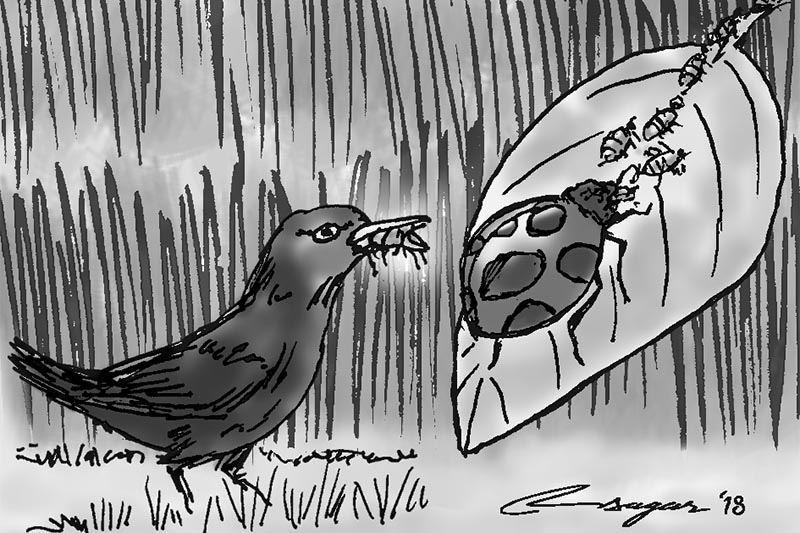Natural pest control: Art of mimicking nature
The best strategies for pest management are based on ensuring optimal conditions for plant growth: a soil rich in organic matter, balanced nutrition, good plant population and a high diversity of plants attracting, repelling harmful insects and promoting predators of all kind
Unlike in agriculture, in nature, we seldom find the massive destruction of vegetation by pest or diseases. We find high biodiversity of plants but also of animals, insects, bacteria and fungi. Nature is a system in which no component can easily dominate. Nature provides and promotes niches for diverse insects and animals competing with each other and living with each other. They die and decompose in the landscape where they live. Nature recycles nutrients.
The introduction of permanent farming has over the years reduced biodiversity. Ecological logic suggests that with decreasing biodiversity above the soil, biodiversity in the soil has also decreased.
Once the product is harvested, farmers apply farmyard manure to replenish the nutrients. But many farms have become too
small to create sufficient manure. This encourages farmers to resort to chemical fertilisers. This creates imbalanced plant nutrition. Imbalanced plant nutrition leads to increased vulnerability to pests and diseases.
The lack of organic matter in soil – caused by erosion, reduced the application of farmyard manure and accelerated decomposition due to nitrogen application – leads to moisture stress, which also increases the susceptibility of plants to pests and diseases.
The reduction of biodiversity in agricultural systems has also increased the relative abundance of insects that can live in such simple ecosystems. In the same way, harmful animals like rats and wild boars can easily survive – there is almost no niche for their predators (snakes, owls, wild cats).
The use of broad-spectrum pesticides has had a severe impact on the abundance of predators. The pest-predator ratio has been severely and negatively impacted. This applies to insects as well as to birds.
The main strategy for pest and disease management in low external input sustainable agriculture, or LEISA farming system, is to reduce stress to the crop and strengthen ecological processes that control pests and disease. This means ensuring that
the crop is not exposed to excessive drought or moisture; subjected to nutrient shortages and imbalances; facing excessive competition from other plants (for space, light, water or nutrients); exposed to extremely high or extremely low temperatures and grown as a monocrop in a landscape almost devoid of trees, shrubs and wild fauna and flora.
How can this be done?
Organic matter in the soil is an important factor in improving growth condition. It will improve soil structure and allow rainwater to infiltrate into the soil. This will reduce run-off and thus increase water availability, reduce water stagnation and provide better growing conditions for plants. It will also improve aeration and oxygen availability in the soil and it will also lower or increase the pH of the soil.
Many elements make up a farming system with high biodiversity.
Biodiversity can be enhanced further by introducing: trap crops (often crops with yellow flowers, like Indian mustard, sunflower, marigold, soybeans and French beans); crops that promote predators (pulses for the lady bird beetle, okra for the lace wing, coriander, sorghum and maize for Trichogramma); visual/physical barriers through densely sown border crops (for example the diamond-backed moth needs to see cabbage).
After such interventions, a field would have about 10 crops growing. It thus becomes a fairly rich ecosystem. The applied compost will provide feed for microbes in the soil which will enhance biodiversity, especially when micro-organisms have been added to the compost. The trees will encourage birds that will feed on bollworm or Spodoptera, for instance, but of course also on grains (the main reason why farmers want to remove trees). So it not only increases vegetative biodiversity but also overall biodiversity.
Another possibility is to create patches of nature on community-owned land within a landscape. The best way to do that is to fence the areas temporarily and prohibit entry for a period of about five years. The nature that regenerates is highly diverse and suitable to the environment. These patches of nature can then be the refuge for large predators. Of course, they are seen by many scientists also as a source of pests and diseases. Only experiments will show who is right.
Crop management is equally important. Time-tested local varieties should be preferred. It would be recommendable to try and improve the varieties by selecting healthy and high yielding plants as the seeds for the next season.
Though it is tempting to work with hybrids to improve yields, it would often be better to grow varieties that have good characteristics. They can be multiplied by the farmer themselves, provided a good system of used selection is implemented.
The best strategies for pest management are based on ensuring optimal conditions for plant growth: a soil rich in organic matter, balanced nutrition, good plant population and a high diversity of plants attracting, repelling harmful insects and promoting predators of all kind.
Only if we fully understand the ecology of pests and diseases, can we live in harmony with them instead of fighting them.






